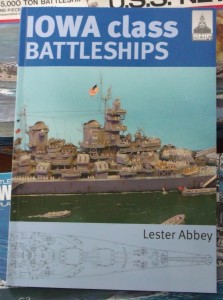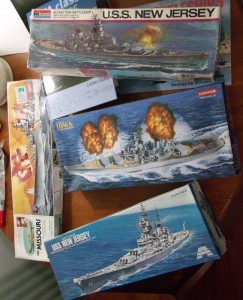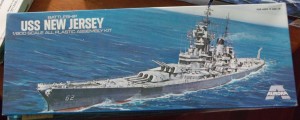I am disappointed with Ship Craft 17 Iowa Class Battleships, while it is still a good overview for somebody just getting into building the iconic battleships it doesn’t pack the information that the excellent Ship Craft 16 Hipper Class Ships does, and in the same number of pages.
Ship Craft 17 (copyright 2012 Seaforth Publishing) fails in, among other areas, the kit review section, primarily in the 1:500 through 1:600 range. It also fails to mention the 1:350 scale Revell kit so I’ll mention it here; stay away from that kit as it is a revised version of the inaccurate Otaki-Life Like Hobbies kit first issued as a World War-2 Missouri in 1971 (revised in 1983 to look like a modernized ship, before being sold to Revell who’s been revising-reissuing it ever since, it was even issued under the Monogram label in the 1990s). Recently Revell-Germany re-issued it with a mass of aftermarket parts to make it look better, but the result is that you have to spend a crap-load of money and end up doing even more work on a kit to make it resemble a ‘modern’ Iowa Class ship.
I’m a fan of 1:600 scale battleships because they’re small enough you can display a lot of them on a single bookshelf and are still big enough that your guests don’t go blind looking at your handy-work. Plus, they were basically the only battleship kits I could get my hands on as a kid in the 1970s. Because the highly praised Ship Craft series failed to discuss these kits, and because I’m amazed at the high prices kit sellers on the internet are demanding for them, I feel compelled to do my own review of these now ancient, and unfortunately crappy kits.
Iowa Class=Iowa, Missouri, New Jersey, Wisconsin
The first offender is Revell’s 1:535 offering. First released in 1953, terrible, inaccurate, does not come with water-screws (propellers) but has one rudder (the real ship has two rudders). Hull bow incorrectly angled, aft end of hull shaped like a step-pyramid. Wood planks on deck represented by continuous raised lines. Anti-aircraft .50 cal guns represented by molded-on crucifixes. Molded on life boats in the upside down position. Blocky looking Seahawk float-planes. The decals for the ship’s hull number are the large ‘shadowed’ post World War-2 type, yet the kit is supposed to be the World War-2 version. Amazingly Revell repeatedly re-issues the crappy kit, and for some odd reason people are willing to pay high prices for it. To make things more confusing, in the mid-1990s Revell began using the original artwork for Monogram’s 1:665 (16 inch) Missouri for its 1:535 Missouri.
Aurora’s 1:600 offering was first released in 1957 (Ship Craft 17 says “in the early 1960’s”), it looks like a scaled down version of Revell’s 1:535 kit. The hull bow has the same angle and the stern has the same stepped pyramid shape, except Aurora gives you four propellers. The propellers are incorrect as they have three blades per screw, the real ship has four bladed screws outboard and five bladed screws inboard. You get one big ugly rudder. The deck detailing is similar to Revell’s except for recessed wood plank lines (which are also continuous/unbroken) and molded on solid railing. The life boats are molded separate, the Seahawks look better than Revell’s. The main gun turrets look like scaled down Revell turrets. Interestingly the Aurora kits are the only ones in this review that provide boarding ladders, but there is no mention of them in the instructions.
From the mid-1960s to mid-1970s Aurora used some excellent artwork on their boxes. For the Iowa Class ships the artist actually did a better job representing the ships than the kit itself. The Missouri is painted in its post World War-2/Korean War guise, still bristling with anti-aircraft guns but minus its Seahawk float-planes. The Iowa also looks to be depicted as post World War-2/Korea, and the New Jersey (the best artwork of the bunch in my opinion) is in its Vietnam War livery with the big rectangular ECM box on its forward tower, and a helicopter pad on its aft deck (unfortunately the artist failed to mount the big antenna on the bow). Regardless of the box artwork each kit is the same World War-2 version, yet the decals for the ship’s hull numbers are the large ‘shadowed’ post World War-2 type (World War-2 hull numbers were small with no ‘shadowing’).
Monogram (not mentioned in Ship Craft 17) entered the Iowa Class race in 1976 with issues of Missouri, New Jersey and Wisconsin (in that order). THEY ARE NOT RE-ISSUES OF AURORA KITS, OR REVELL KITS! Also, I’ve seen them listed as 1:600 scale, they are a smaller 1:665 scale. The odd scale is the result of Monogram deciding to issue battleship kits based on a standard 16-inch (40cm) hull (as stated on the box), rather than a ‘constant scale’. The hull has the best looking bow of the bunch, even has the three ‘eyes’ for anchors and cables, however, there are mysterious vertical lines along the hull sides (the real ships have noticeable horizontal lines down the length of the hull), and the stern is still incorrectly shaped. You get four propellers but they’re all four bladed. The most accurate looking parts of this kit are the two rudders and the excellent looking secondary gun turrets-guns (which are the same size as 1:600 scale Aurora/Otaki). Amazingly for a late 1970s issued kit the deck looks like it came right outta the 1950s (which might explain why some people think its a revised issue of the Revell or Aurora kits), it even has the raised wood deck lines and crucifix .50 caliber machine guns similar to Revell’s. There are two Kingfisher float-planes and the hull number decals are the small WW-2 type, yet the main mast looks like the type fitted after WW-2.
In 1984 Japan’s Otaki issued a 1:600 scale motorized version of a modern Iowa Class ship (not mentioned in Ship Craft 17). In the mid-1980s Otaki became Arii and it was issued under that label. It has been ripped-off and issued by Korea’s Kangnam and China’s Lee (aka C.C. Lee, aka Shanghai C.C.Lee Model Company). It is currently issued by Japan’s MicroAce (the new Arii). From here on out I’ll refer to this kit as The Asian Kit. The kit is totally lacking in detail, and even though the hull and deck size is similar to Aurora’s 1:600 hull/deck the main gun turrets are as big as the bigger Revell kit’s turrets. The helicopters are crappy, the Harpoon anti-ship missile launchers are a bad joke, the secondary gun turrets are chunks with stubs for guns, the Phalanx gatling gun systems are fat and missing the barrels. The life boats are huge. The stern of the hull is close to being accurate, but the propellers are all four bladed, you get two rudders. The kit is not worth the full U.S. MSRP (Manufacture’s Suggested Retail Price) that the majority of internet sellers demand.
Here’s more depressing news; Main Gun Turrets-Guns: Aurora’s turrets are the smallest yet resemble Revell’s, also the guns are as big as The Asian Kit’s. The Asian Kit’s turrets are almost as big in diameter as Revell’s, they are devoid of detailing, except for recessed ladders. Revell’s main gun tubes will not fit into Revell’s turrets. Monogram’s turrets are slightly bigger than Aurora’s, the guns look the most accurate, are the same diameter as the 1:600 scale kits, but shorter in length, the anti-aircraft gun enclosures on the top of the turrets are the wrong shape.
Superstructure: All kits lack detailing. The Asian Kit is the worst offender completely devoid of details, it is molded separately and look like that ancient underwater ‘structure’ known as Yonaguni Submarine Ruins.
Here’s some pictorial evidence to back up accusations against the offenders (click each pic to view more in the full-sized image):
- Ignore the red paint on the Monogram kit, it doesn’t come that way.
- The Asian Kit is best without being accurate.
- The ‘eyes’ have it for Monogram.
- From top to bottom: Monogram, Revell, Aurora, The Asian Kit.
- Back to Front: Monogram, Revell, Aurora, The Asian Kit.
- From right to left: Monogram, Aurora, The Asian Kit, Revell.
- From left to right: Monogram, Aurora, The Asian Kit, Revell.
- Floatplanes, rudder, crane, anchors.
- Floatplane, crane, catapults, life boat.
- Floatplanes, floats, crane, anchors.
- Rudders
- Water screws
- Main mast
- Helicopters
- Water screws
- Phalanx
- Tomahawk cruise missile launcher boxes
- Harpoon anti-ship missile launchers
- The small one is Aurora’s, the big one is The Asian Kit’s.
- Boarding ladders included but not talked about.
There’s no excuse for Revell’s continuous re-issuing of their crappy kit (in fact they’ve just re-issued it again). You’d think with the merging of Revell and Monogram, in the 1990s, they’d issue the better Monogram kit. It should be noted that Monogram’s 16 inch Iowa kits were rarely issued (for some unknown reason), along with Monogram’s 16 inch Bismarck/Tirpitz (which works out to about 1:615/17 scale, a 1:600 scale Bismarck hull is approximately 16 & 3/8th inches long). I remember reading an article, many years ago, that was talking about a train derailment and fire that destroyed many of the Aurora molds that had just been purchased by Monogram. I believe it happened in 1979, the Monogram 16 inch battleship kits were originally issued between 1976 and 1978. It would make sense that they were never issued again if their molds were also destroyed in that train fire, and it would explain why both the Monogram and Aurora kits command high prices on the internet, however, I’ve seen issues of the Monogram 1:665 (16 inch) Iowa kits in 1990s style boxes, and even the original late 1970s boxes but with 1990s style Skill Level 2 stickers on the shrink-wrap (you can’t trust the copyright date on boxes as being indicative of when that particular kit was issued).
Regarding Ship Craft 17, it’s still a great starting point for learning about the ship and has enough information in the text that you’d realize there isn’t, as yet, a model kit in any scale of the Iowa Class that doesn’t have some discrepancy (which is amazing considering the historical importance of the world’s last and best battleships).
It would take a lot of work to correct the old American kits. The Asian Kit’s near total lack of detail has an advantage; it makes it easier to detail-up with aftermarket parts and scratch building, you could even back date it to Vietnam, Korea or WW-2. There are plenty of aftermarket photo etched sets for 1:600 Fast U.S. Battleships, and a company called Model Monkey is producing 1:600 scale 3D printed ‘correction’ parts, including an early WW2 rounded bridge for the New Jersey.
I end this review by appealing to Hornby-Airfix to produce a new line of 1:600 scale Iowa Class ships, including options for World War-2, Korea, Vietnam and Desert Storm.
ITALERI 1:720 DEUTSCHLAND, LUTZOW, SCHEER & GRAF SPEE


























